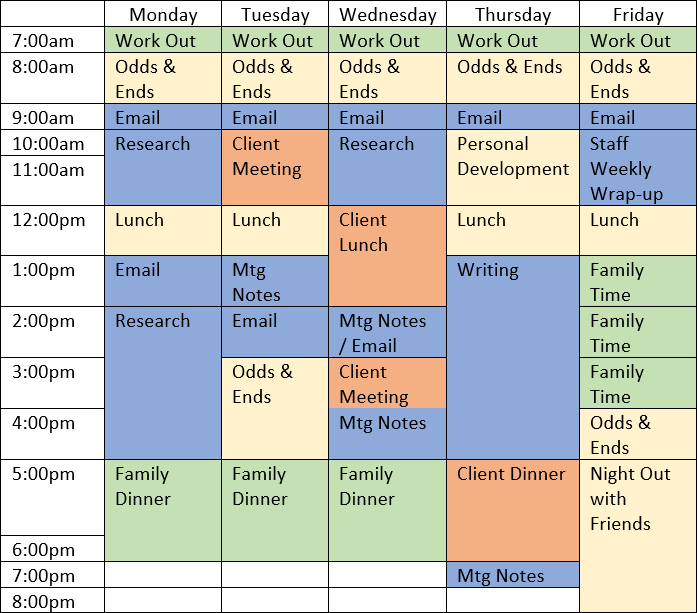Even during pre-pandemic times, Small Business Owners may find it challenging to fit everything into their schedule. Now, with many people running their businesses from home, they’re faced with the challenges of increasing household demands and extra time spent assisting children with schoolwork. Finding time to accommodate a multitude of requests from all aspects of life can be overwhelming. This is when developing a Model Week may help Small Business Owners stay focused and organized.
A Model Week is a sample structure for time allocation that is repeated weekly. Start by listing out all the components of your week. This may include: Client Meetings, Research, Writing, Personal Development, Gym Time, Family Time, Lunch/Dinner, Odds & Ends, or any number of events.
The next step is to set priorities and note whether each component is negotiable or non-negotiable. It may help to color code the events as you insert them into your schedule. For example, you may choose to color all non-negotiable events red, while negotiable events are purple. If you prefer to be more precise, you could choose a separate color for each type of event.
Insert the non-negotiable events into your calendar first. Out of the remaining negotiable events, what are your highest priorities? These priorities will be different for everyone. As you contemplate which events are negotiable or non-negotiable and which are your highest priorities, you may want to drill down to specifics. Work may fall into the non-negotiable category, but are all work tasks non-negotiable? Are there some tasks that may be a lower priority than family time? If family time is your priority, you may decide to set a boundary for yourself that you won’t engage in work activities on Sundays.
Maybe instead of meeting with clients in the morning, you combine your client meeting with a socially-distanced lunch, so you can spend the morning getting the kids situated for school, while your spouse takes over in the afternoon. Maybe you choose to reduce your time at the gym from 2 hours to 1 hour to accommodate the additional time with children due to Stay at Home orders. Are there activities you could participate in during family time that would still promote your fitness goals – like going for a bike ride with the kids instead of the hour you would’ve spent riding a bike at the gym? Allow yourself some creativity and flexibility.
Once you’ve established your priorities, start filling in your calendar with the time blocks you’ve established. Revise and look for creative solutions if you find there isn’t enough time available. You may need to go back to your priorities list and decide if you’re willing to remove tasks that aren’t top priorities. Now is the time to decide if you’ll say yes or no to these tasks. Having an established Model Week will assist you with saying no to tasks that aren’t on your priority list. You may also want to take a few moments to record how you’ll respond to these requests when they inevitably hit your inbox. Have a polite, yet firm response prepared, so you don’t cave in the moment to unwanted demands.
Next comes the fun part! As requests that align with your priorities come in, add them into the corresponding time blocks on your schedule. Once that time block is full for the week, you can fill in future weeks. Remember to be flexible. Not every week will align perfectly, but this will give you a head-start as you begin arranging your schedule consciously instead of wondering how you became so overwhelmed with tasks you had no interest in doing.
A Model Week is a sample structure for time allocation that is repeated weekly. Start by listing out all the components of your week. This may include: Client Meetings, Research, Writing, Personal Development, Gym Time, Family Time, Lunch/Dinner, Odds & Ends, or any number of events.
The next step is to set priorities and note whether each component is negotiable or non-negotiable. It may help to color code the events as you insert them into your schedule. For example, you may choose to color all non-negotiable events red, while negotiable events are purple. If you prefer to be more precise, you could choose a separate color for each type of event.
Insert the non-negotiable events into your calendar first. Out of the remaining negotiable events, what are your highest priorities? These priorities will be different for everyone. As you contemplate which events are negotiable or non-negotiable and which are your highest priorities, you may want to drill down to specifics. Work may fall into the non-negotiable category, but are all work tasks non-negotiable? Are there some tasks that may be a lower priority than family time? If family time is your priority, you may decide to set a boundary for yourself that you won’t engage in work activities on Sundays.
Maybe instead of meeting with clients in the morning, you combine your client meeting with a socially-distanced lunch, so you can spend the morning getting the kids situated for school, while your spouse takes over in the afternoon. Maybe you choose to reduce your time at the gym from 2 hours to 1 hour to accommodate the additional time with children due to Stay at Home orders. Are there activities you could participate in during family time that would still promote your fitness goals – like going for a bike ride with the kids instead of the hour you would’ve spent riding a bike at the gym? Allow yourself some creativity and flexibility.
Once you’ve established your priorities, start filling in your calendar with the time blocks you’ve established. Revise and look for creative solutions if you find there isn’t enough time available. You may need to go back to your priorities list and decide if you’re willing to remove tasks that aren’t top priorities. Now is the time to decide if you’ll say yes or no to these tasks. Having an established Model Week will assist you with saying no to tasks that aren’t on your priority list. You may also want to take a few moments to record how you’ll respond to these requests when they inevitably hit your inbox. Have a polite, yet firm response prepared, so you don’t cave in the moment to unwanted demands.
Next comes the fun part! As requests that align with your priorities come in, add them into the corresponding time blocks on your schedule. Once that time block is full for the week, you can fill in future weeks. Remember to be flexible. Not every week will align perfectly, but this will give you a head-start as you begin arranging your schedule consciously instead of wondering how you became so overwhelmed with tasks you had no interest in doing.


